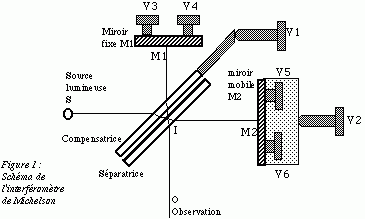-
 Koch Bacillus
Koch Bacillus
-
 Young modulus
Young modulus
-
 Eccentric
Eccentric
-
 Physical model
Physical model
-
 Emulsion
Emulsion
-
 Asynchronous
Asynchronous
-
 Hubble constant
Hubble constant
-
 Magnetometer
Magnetometer
-
 Sodium-rich rock
Sodium-rich rock
-
 Banana
Banana
-
 Mycosis
Mycosis
-
 ppm
ppm
-
 ASCII
ASCII
-
 Second of arc
Second of arc
-
 Mechatronics
Mechatronics
-
 Food additive
Food additive
-
 Passive continental margin
Passive continental margin
-
 Ozonosphere
Ozonosphere
-
 Upload
Upload
-
 Quartzite
Quartzite
-
 Dendrite
Dendrite
-
 Ferralisation
Ferralisation
-
 Package
Package
-
 Columbia
Columbia
-
 Wetland
Wetland
-
 Echocardiogram
Echocardiogram
-
 Volcanic arc
Volcanic arc
-
 Chilblain
Chilblain
-
 Pink siris
Pink siris
-
 Phoenicopteriformes
Phoenicopteriformes
Michelson interferometer
The Michelson interferometer is a split beam device. It can therefore produce local interference patterns from extended sources.
A half-silvered mirror called a beam splitter divides a light beam into two perpendicular beams of the same amplitude. Each of these beams is then reflected by a mirror back to the beam splitter to become two beams propagating in the same direction. These two beams have a path difference which depends on the distance and the angle between the two mirrors: They can therefore interfere.
If one of the mirrors is replaced by its image in the beam splitter, the system can be seen to be equivalent to an air blade of which the thickness and angle can be varied.
Two types of interference can occur:
- if the plate has parallel faces, fringes (rings) of equal inclination situated at infinity can be observed (in practice, in the focal plane of a lens). The size of the source does not matter.
- if the plate is a wedge of air (of small thickness), fringes (rectilinear) of equal thickness situated in the region of the blade, hence of the mirrors, can be observed. Here, a fairly extended source can be used (especially since the mean thickness is low).
Compensator: to ensure the perfect symmetry of the two paths, a "compensating" plate is placed in front of the beam splitter so that the two beams pass through the same thickness of glass.

Michelson interferometer
Latest
Fill out my online form.



